2004 Hyundai Coupe heater
[x] Cancel search: heaterPage 293 of 389

2
DRIVING YOUR HYUNDAI
17
In addition, anti-freeze solution must ALWAYS be used in vehicles fittedwith air conditioning, to prevent the heater matrix from freezing and sub- sequently bursting with the refrigera-tion system in use. ZC170D1-E Door Locks Should the door lock mechanism be- come frozen, a proprietary lock de-icer should be used. Alternatively, warm- ing the door key may thaw the doorlock. However, the key should be handled carefully to avoid burning the fingers.Never attempt to thaw a frozen door lock using hot water, since the water will eventually freeze and compoundthe problem. NOTE: The proper temperature for using the immobilizer key is from -40°F (- 40°C) to 176°F (80°C). If you heat the immobilizer key over 176°F (80°C)to open the frozen lock, it may cause damage to the transponder in its head. SC170E1-E Windscreen Washers and Wip- ers The windscreen washer bottle should be filled with a solution of water and a proprietary winter screen wash addi-tive. The windscreen wipers should not be used if the blades are frozen to the windscreen or if they are coveredwith snow, before this is removed. NOTE: Never allow undiluted screen washer fluid additive to spill upon the paintwork or use engine cool- ant anti-freeze since damage to thepaintwork may result.
o When driving in extreme conditions,
the windscreen wiper blades may fail to clear the screen properly due to the formation of ice upon theblade edge. It will therefore be nec- essary to periodically remove such ice to restore their efficiency.
o If the power operated door mirrors become frozen, attempts to adjustthese may damage the mechanism. o The formation of snow or ice built up
inside the wheel arches may inter-fere with the road wheels or steering mechanism. In such instances, un- usual noises or an increase in steer-ing effort may result. Therefore, ensure that the wheel arches are checked periodically and any accu-mulated snow or ice removed.
o It is advisable to carry emergency
equipment including, torch, shovel,tow rope, blankets etc., if a journey is to be undertaken into areas of severe road conditions.
Page 336 of 389

6OWNER MAINTENANCE
10
SG050B1-E
Coolant recommendations
Only ethylene glycol based coolant with a corrosion inhibitor suited to aluminium alloy engine components should be used in the cooling system.No further additives or inhibitors should be used. The coolant specific gravity should be checked as pre-scribed in the maintenance schedule to ensure adequate frost and corro- sion protection. In addition, the en-gine coolant must be replaced at the specified interval since the corrosion inhibitor properties deteriorate withtime.It is important to note that whilst anincrease in the concentration of anti freeze gives an increase in the level of frost protection, a solution which isin excess of 65% anti freeze will result in reduced frost protection and engine overheating. Therefore therecommended concentration of 50% should not be exceeded for general use. The use of methanol based anti freeze compounds may result in engine over- heating and will invalidate the vehiclewarranty.
!
ENGINE COOLANT CHECK- ING AND REPLACING
SG050A1-E
WARNING:
Do not remove the radiator cap
when the engine is hot, since the system is pressurized and coolant may be ejected from the radiator resulting in scalding. NOTE: It is imperative that vehicles fitted
with an air conditioning system have a coolant concentration of the recommended strength at all times. The use of the air condition-ing system when the cooling sys- tem is filled with water only will result in the heater matrix freezingand subsequently bursting.
Page 337 of 389

6
OWNER MAINTENANCE
11
HGK4006
SG050C1-E
Engine Coolant Level
The engine coolant level may be
observed through the side of the plas- tic coolant reservoir (expansion tank) when the engine is cold. If the level is below the "L" mark, add coolant ofthe correct concentration until the level is between the "L" and "F" marks. If the level falls below the "L" mark on aregular basis despite being topped up, consult a Hyundai dealer. SG050D1-E
To Change the engine Coolant
The engine coolant should be changed at those intervals specified in the ve- hicle maintenance schedule in Sec- tion 5. NOTE: Care should be taken to ensure that coolant is not allowed to spill onto the paintwork since the fin- ish may become damaged. If cool-ant spillage occurs, the affected area should be rinsed thoroughly with water.
1. Park the vehicle on level ground and ensure that the parking brake is firmly applied, and the engine allowed to cool.DO NOT ATTEMPT THIS OPERA-TION WHILST THE ENGINE ISHOT SINCE BURNING OR SCALDING MAY RESULT.
2. Prepare a suitable receptacle to collect the displaced coolant andposition this under the radiator drain tap. 4. When the engine coolant has
drained completely, close the drain tap ensuring that this is not over tightened. G050D03E
3. With the heater temperature con-
trol set to the "HOT" position, re-move the radiator cap and open the radiator drain tap.
Page 388 of 389

10INDEX
4
Map light ................................................................... 1-61
Multi functi on switch................................................. 1-50
Multi gauge ............................................................... 1-49
O Odometer .................................................................. 1-46
Outside rearview mirror heater ................................. 1-63
PParking brake ............................................................ 1-64
Pollen filter ................................................................ 1-91
Power steering fluid level ................... ....................... 6-31
Power steering hoses ............................................... 6-30
Power window ........................................................... 1-11
Pre-tensioner seat belt .............................................. 1-28
Protecting your hyundai from corrosion ...................... 4-2
R Rear fog light switch ................................................. 1-54
Rear parcel shelf ....................................................... 1-18
Rear seat entry ......................................................... 1-16
Rear seat pos itions................................................... 1-16
Recommended shift points ......................................... 2-7
Remote fuel filler lid releas e .....................................1-66
Replacing light bulbs ................................................. 6-33
Running in your nero Hyundai .................................... 1-3SScheduled maintenance
.............................................. 5-4
Seat belt pr ecautions................................................ 1-18
Seat belts (3-point type) .... .......................................1-21
Seat cushion height adjustm ent ...............................1-15
Seat warmer .............................................................. 1-15
Service history ............................................................ 5-1
Smooth cornering ...................................................... 2-16
Snow tyres .................................................................. 8-4
Spare tyre ................................................................... 3-5
Sparking plug replacement .......................................6-13
Spectacle case .......................................................... 1-61
Speedometer ............................................................. 1-45
Starting the engine ...................................................... 2-3
Steering wheel freeplay ............................................ 6-26
Steering wheel tilt lever ............................................ 1-69
Stereo sound system ................................................ 1-92
Sun viso r ................................................................... 1-68
Sunroof ...................................................................... 1-59
Supplemental restraint (airbag) system ....................1-30
T Tachometer ............................................................... 1-45
Theft-alarm system ..................................................... 1-8
Trailer or vehicle towing ............................................ 2-18
Electronic stability program (ESP)............................ 2-13
Trailer or vehicle towing tips..................................... 2-21